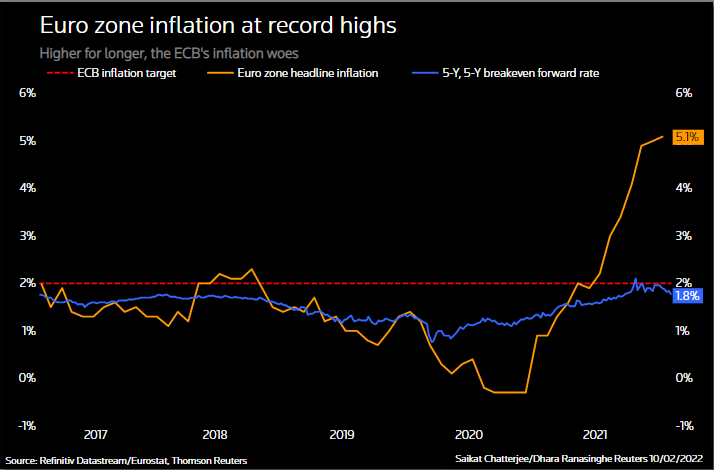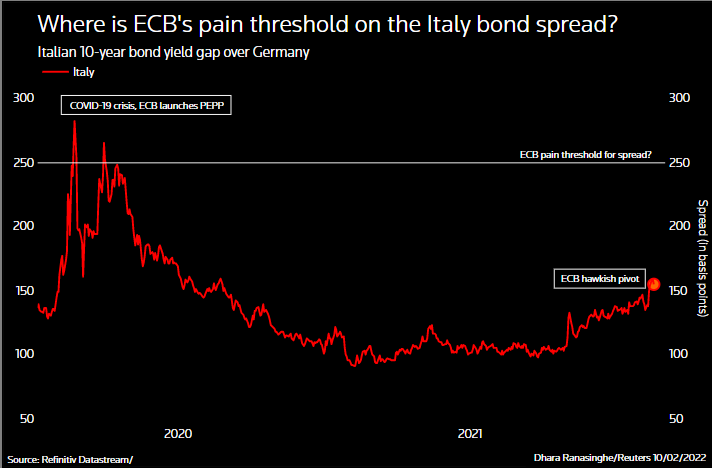Analysis-For Euro Zone Bond Markets, The ECB 'Put' Is Some Way Off
Worried about record-high inflation, the European Central Bank may have significantly raised the threshold where it might staunch bond market sell-offs in Italy and other weaker euro bloc countries.
Markets across poorer, debt-laden southern Europe reacted with shock to the ECB's move to walk back earlier pledges not to raise rates this year. They recoiled too at the signal that its bond-buying scheme -- a lifeline for southern Europe -- could be unwound sooner and faster than expected.
The hawkish pivot sharply lifted yields on ten-year bonds from Italy, Greece, Spain and Portugal -- collectively dubbed the euro zone periphery -- relative to safer German equivalents.
The premium on Italy, arguably most vulnerable because of the sheer size of its debt, is up 20 basis points in the past week.
ECB President Christine Lagarde has since seemed to soften her stance. But she hasn't banished fears that policy tightening will sharply raise borrowing costs, exacerbating debt ratios that are already among the world's highest.
Graphic: Euro zone inflation at record highs-

The question many ask is where the ECB 'put' might kick in -- a term normally used to describe the view that the U.S. Federal Reserve will eventually backstop falling stock markets.
Since 2015, the ECB has bought member states' bonds, capping their borrowing costs. And since March 2020 PEPP, its emergency stimulus scheme to cope with the coronavirus pandemic, has enabled the periphery to borrow more cheaply.
Italian 10-year yields for instance, spiked to 3% just before PEPP was launched but fell as low as 0.4% at one point last year.
JPMorgan called ECB stimulus "a safety net for the periphery", without which bond markets risked fragmenting along national lines, dividing the vulnerable, indebted south from Germany and other richer states.
Noting Lagarde's promise after last week's policy meeting that the ECB is "obviously going to respond" to any sharp spread widening, JPM predicted "the market may be willing to test this commitment."
Indeed, it brings to mind Lagarde's comment early in her role that the ECB was not there to "close spreads" i.e. narrow yield premia.
The ensuing spread blowout forced the ECB to announce PEPP.
What's changed since then is that bloc-wide inflation is running at a record high 5.1%, after years of failing to reach the ECB's target.
"It's the first time since 2012 that there's potentially conflict between inflation and dealing with fragmentation," AXA Group chief economist Gilles Moec said.
INFLATION VS SPREADS
Danske Bank chief strategist Piet Haines Christiansen says the ECB might be willing to tolerate higher yields for the periphery.
"Back in the day, the pain threshold would have been lower, but with inflation higher, Italy is increasingly on its own," Haines Christiansen said.
"Previously I would have said that 250 bps on the Italian/German spread is the pain threshold for the ECB, PEPP was announced at around 300 bps, and now I would say it is higher."
Pictet Wealth Management strategist Frederik Ducrozet saw the 'danger zone' for the Italy bond spread at around 250 bps -- roughly 100 bps above current levels.
Graphic: Where is the ECB's pain threshold on the BTP/Bund spread-

For David Riley, chief investment strategist at BlueBay, "we'd have to go through a 200 bps spread before we get close to the ECB put."
However, despite Italy's debt-to-GDP ratio exceeding 150%, concerns won't arise immediately because the country has used the low rates era to extend the average maturity of its debt to seven years.
Haines Christiansen said debt sustainability questions would only arise when yields on Italy's seven-year bonds rose 150 bps from current levels..
Capital Economics senior Europe economist Jack Allen-Reynolds sees concern arising only once 10-year Italian yields hit 5%.
CLARITY NEEDED
Any sovereign bond sell-off that causes a jump in corporate borrowing costs would grab policymakers' attention.
How could they respond?
The ECB could check borrowing costs by targeting where it reinvests the proceeds of maturing PEPP bonds. Or it could leave the door open to re-starting bond purchases if needed.
Analysts said they hoped the ECB would provide more clarity at its March meeting over what support would be provided to the periphery if spreads continue to widen.
But at current levels, BlueBay's Riley reckons "we are long away off from the ECB put". So despite sharply higher Italian yields, "in the near term, that's not a knife I'd be looking to catch", he added.
© Copyright Thomson Reuters {{Year}}. All rights reserved.





















